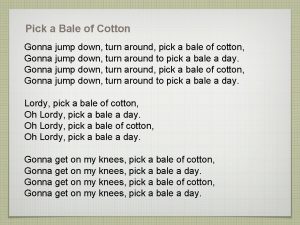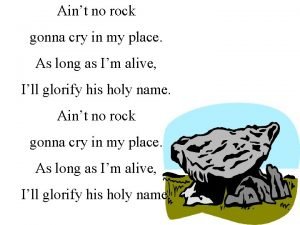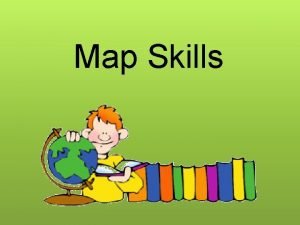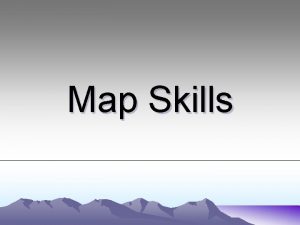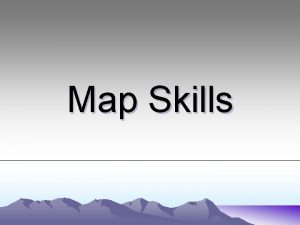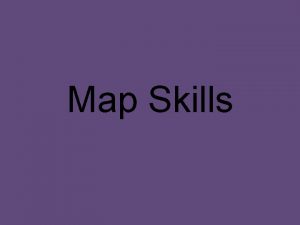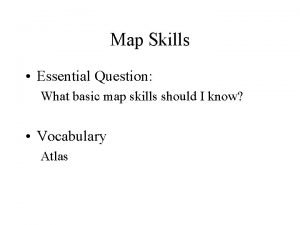Were gonna learn some Map Skills Types of


















- Slides: 18

We’re gonna learn some Map Skills

Types of Maps n n Maps do not always provide information about where you are in the world Maps can contain information about agricultural areas, population density, election results, weather patterns, etc

Agricultural Map

Population Density Map

Road Map

Political Map

Physical Map

Topographic Map

Relative Location n n Relative location is location according to the map’s compass rose. The compass rose helps to orient the mapreader as to direction. (Not all maps are designed with North at the top. )

Directions n Cardinal directions are North, South, East, and West. n Intermediate directions are Northeast, Northwest, Southeast, and Southwest.

Map Legend n The legend is a guide for helping to read a map – colors or symbols used in the map are usually explained here.

Map Grid n n A grid is a system of vertical and horizontal lines. Each vertical line is labeled along the top of the map with letters from the alphabet beginning with A. The horizontal lines will be labeled along the sides of the map with numbers, usually starting from 1. If you want to find a certain location, there is an index. An index is a list of the locations and their letter/number spots.

n n n If the map is drawn to scale, the scale is usually included near the legend. For example, on a map who’s scale is 1 inch = 20 miles, measuring a distance of say 3 inches between two cities on the paper map would mean that the actual distance is 60 miles (1 inch/20 miles = 3 inches/ ? miles) Sometimes a scale bar is drawn for you and divided into parts to help you measure distances on a map.

Sometimes it is easier to look at a globe to more accurately “see” the locations of various places. It is impractical to carry around curved maps (globes) so map makers have found a way to draw the round earth on a flat surface. This is called a projection.

Absolute Location Absolute location is location according to lines of latitude and longitude that have already been established by mapmakers.

Latitude Lines n n n Latitude lines run horizontal. The equator is one of these latitude lines The equator divides the earth into the Northern and Southern hemispheres.

Longitude Lines n n n Longitude lines run vertically. The Prime Meridian is one of the longitudinal lines The Prime Meridian divides the earth into the Eastern and Western hemispheres.

n n Any place on the globe can be accurately pinpointed by these latitude and longitude readings (absolute location). Maps that are projected (curved surfaces drawn on flat paper) have the grid system formed by lines of latitude and longitude labeled so we can tell exactly where we are on the globe.
 Were going on a bear hunt we're gonna catch a big one song
Were going on a bear hunt we're gonna catch a big one song Freedom we know
Freedom we know Kinetic learning
Kinetic learning Whats a main idea
Whats a main idea Soccer players learn many skills when playing soccer
Soccer players learn many skills when playing soccer They say it only takes a little faith
They say it only takes a little faith They say it only takes a little faith to move a mountain
They say it only takes a little faith to move a mountain Ice cream uncountable
Ice cream uncountable Contact forces
Contact forces Some say the world will end in fire some say in ice
Some say the world will end in fire some say in ice Some say the world will end in fire some say in ice
Some say the world will end in fire some say in ice Some trust in horses
Some trust in horses Wherever you lead me i'm gonna follow
Wherever you lead me i'm gonna follow Onomatopoeia in the song roar
Onomatopoeia in the song roar Lion king william shakespeare
Lion king william shakespeare Gonna buy me a knife with a blade ten inches long
Gonna buy me a knife with a blade ten inches long Jump down pick a bale of cotton
Jump down pick a bale of cotton Who you gonna call
Who you gonna call Ain't no rock gonna cry in my place
Ain't no rock gonna cry in my place
















